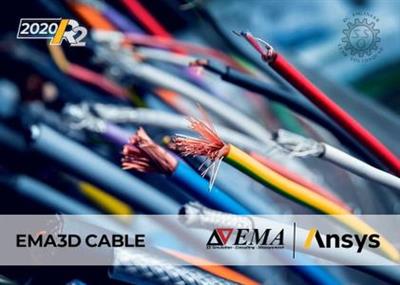
ANSYS EMA3D Cable 2020 R2 | 2.4 Gb
Electro Magnetic Applications, Inc. (EMA) and Ansys are partnering to deliver an enhanced design-to-validation workflow for certifying cable harness models in aircraft and automobiles.
The workflow greatly reduces electromagnetic interference (EMI) risks to cable harnesses, slashes development time, speeds certification and expedites new products to market faster than ever.
Designing cable harnesses for automotive and aerospace equipment is a daunting engineering challenge. This is primarily due to the difficulty in assessing the impact of electromagnetic (EM) effects induced by factors such as interference, crosstalk, insufficient shielding and lightning strikes. It is critical to mitigate these EM problems to meet stringent demands for electromagnetic interference/compatibility (EMI/EMC) certification of cable harnesses.
Widely used in automobiles, airplanes, ships and spacecraft, cable harnesses are crucial for transmitting electrical power and control signals to the electronics within these vehicles. Due to the size of these vehicles, cables are usually designed, installed and routed to extend over long distances to connect the electronic equipment. They must be protected from external EM sources such as high-intensity, radiated fields (HIRF) or a lightning strike.
Ansys EMA3D Cable, developed exclusively to design and accurately simulate EM effects in cable harness models, can overcome these problems. EMC tests of cable harnesses for large platforms are extremely expensive. With this new simulation tool, engineers can virtually predict the performance of their cable harness under these EMC certification tests economically and early in the design cycle.
EMA3D Cable is the product from a partnership between ANSYS, Inc. and Electro Magnetic Applications, Inc. (EMA), a leading 3D simulation, consulting and measurement company. It is a robust platform-level EMI/EMC cable design and simulation solution. It helps engineers identify EMI/EMC problems in automotive and aerospace devices along with RF systems. EMA3D Cable's accuracy enables cable simulations to be used as the basis for final acceptance or certification.
It uses Ansys SpaceClaim's Direct Modeler UI, known for its ease-of-use, to create and import geometries of arbitrary shapes and sizes. EMA3D Cable enables the user to quickly define the contents of the cable and simulate the model with just a few mouse clicks. This solution bolsters Ansys' design-to-validation workflow to include cable certification support as well as system level EMI analysis for cable harness models.
Ansys EMA3D Cable for Cable Harness Simulation
Founded in 1970, ANSYS employs nearly 3,000 professionals, many of whom are expert M.S. and Ph.D.-level engineers in finite element analysis, computational fluid dynamics, electronics, semiconductors, embedded software and design optimization. Our exceptional staff is passionate about pushing the limits of world-class simulation technology so our customers can turn their design concepts into successful, innovative products faster and at lower cost. As a measure of our success in attaining these goals, ANSYS has been recognized as one of the world's most innovative companies by prestigious publications such as Bloomberg Businessweek and FORTUNE magazines.
Product: ANSYS EMA3D Cable
Version: 2020 R2
Supported Architectures: x64
Website Home Page : Language: english
System Requirements: PC *
Size: 2.4 Gb
Ansys 2020 R2 Supported Platforms
- Windows 10 (64-bit Professional, Enterprise and Education editions, including FIPS mode support for most products)
- Windows Server 2016 Standard Edition (64-bit)
- Windows Server 2019 Standard Edition (64-bit); Microsoft HPC Pack not supported with this release
We support versions of Windows 10 from the Semi-Annual Channel as are available at the time of the Ansys
release. For SCADE products, code generators are qualified/certified on Windows using long term service versions
(LTSB/LTSC).
Additional Hardware and Software Requirements
- Intel 64 / AMD64 system with the correct operating system version installed
- 8 GB of RAM (Minimum)
- 128 GB free on the hard drive is recommended
Minimum Graphics Requirements
ANSYS Products (other than Discovery Live), Windows Platforms: Discrete graphics card with the latest drivers and compatible with the supported operating systems. For full functionality, use of a recent NVIDIA Quadro or AMD Radeon Pro card with at least 1 GB of discrete video memory and supporting, at a minimum, OpenGL version 4.5, DirectX 11, Shader Model 5.0
ANSYS Discovery Live: NVIDIA Discrete graphics card (Quadro recommended) with the latest drivers. Kepler-, Maxwell-, Pascal-, Volta, or Turing-based cards are recommended (Maxwell 2000 or better). At least 4 GB of discrete video memory (8 GB recommended). OpenGL version 4.5 or above.
GPGPU: Some ANSYS products support problem solving on the graphics processor (GPGPU capability). The additional graphics card requirements for GPGPU are included in the GPU Accelerator Capibilities document at ansys.com> Support> Platform Support
Virtual Desktop Infrastructure
In addition, Ansys 2020 R2 supports the following Virtual Desktop Infrastructure:
- VMware Horizon View 7.9 (Windows 10 and Server 2016, 2019) with VMware vSphere ESXI 6.5 U2 (Hypervisor Layer)
- Citrix XenDesktop 7 1909 (Windows 10 and Server 2016) with Citrix Hypervisor 8.0
Compilers
To take advantage of improving compiler technologies, Ansys updates supported compilers from time to time. The following compilers are supported for user-programmable features and functions at Ansys 2020 R2:
- Visual Studio 2017 (Windows)
- Intel Parallel Studio XE 2019, Update 3 (Windows and Linux)
Download link:
Links are Interchangeable - No Password - Single Extraction
